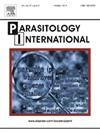在赞比亚,利什曼原虫血清阳性的狗的流行率很高
IF 1.5
4区 医学
Q3 PARASITOLOGY
引用次数: 0
摘要
家犬是幼利什曼原虫的主要宿主,幼利什曼原虫是人类内脏利什曼病的病原体。尽管该疾病在世界上广泛传播,但在赞比亚,内脏利什曼病或任何其他疾病形式的负担记录很少,这主要是由于缺乏监测。最近,赞比亚报告了三例本地犬利什曼病(CanL),此前几十年推定该病没有发生。这一发现表明可能出现疾病,因此需要确定感染疫源地。因此,在这项研究中,我们于2022年7月对赞比亚两个人口稠密的城市地区的家狗进行了首次大规模利什曼原虫感染血清学调查。在一些研究地点,血清阳性高达17%,表明可能存在利什曼原虫传播热点。此外,在对血清阳性犬的随访调查中,抗利什曼抗体的存在是犬存活的危险因素(相对风险= 7.9;优势比= 42.5)。我们的研究结果表明,利什曼原虫感染可能是赞比亚家养狗的健康问题。考虑到人畜共患病传播的风险,赞比亚强调需要改进对人类、狗和沙蝇媒介的疾病诊断和监测。本文章由计算机程序翻译,如有差异,请以英文原文为准。

A high prevalence of dogs seropositive to Leishmania in Zambia
Domestic dogs are the main reservoir of Leishmania infantum, a causative agent of visceral leishmaniasis in humans. Although the disease is widespread in the world, the burden of visceral or any other disease form of leishmaniasis is poorly documented in Zambia, largely due to lack of surveillance. Recently, three cases of autochthonous canine leishmaniasis (CanL) were reported in Zambia following decades of presumed disease absence. This finding intimated probable disease emergence, raising the need for the identification of infection foci. Thus, in this study, we conducted the first mass serological survey for Leishmania infections in domestic dogs from two densely populated urban areas of Zambia in July 2022. In some of the study sites, seropositivity was up to ∼17 %, suggesting probable presence of Leishmania transmission hot spots. Moreover, on follow-up surveys of seropositive dogs, presence of antileishmanial antibodies was a risk factor for dog survival (relative risk = 7.9; odds ratio = 42.5). Our findings implies that Leishmania infection can be a health issue in domestic dogs in Zambia. Considering the risk of zoonotic transmission, the need for improved disease diagnosis and surveillance in both humans, dogs and sand fly vectors is highlighted in Zambia.
求助全文
通过发布文献求助,成功后即可免费获取论文全文。
去求助
来源期刊

Parasitology International
医学-寄生虫学
CiteScore
4.00
自引率
10.50%
发文量
140
审稿时长
61 days
期刊介绍:
Parasitology International provides a medium for rapid, carefully reviewed publications in the field of human and animal parasitology. Original papers, rapid communications, and original case reports from all geographical areas and covering all parasitological disciplines, including structure, immunology, cell biology, biochemistry, molecular biology, and systematics, may be submitted. Reviews on recent developments are invited regularly, but suggestions in this respect are welcome. Letters to the Editor commenting on any aspect of the Journal are also welcome.
 求助内容:
求助内容: 应助结果提醒方式:
应助结果提醒方式:


